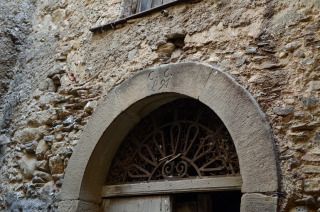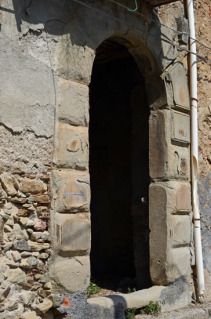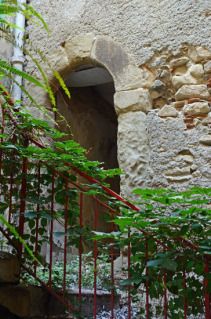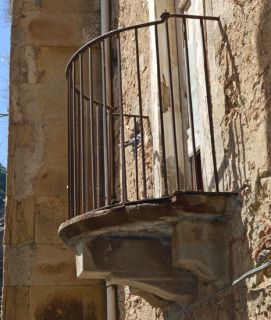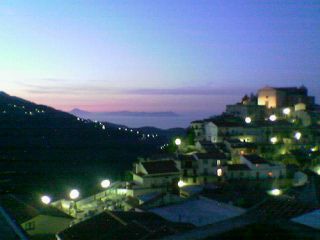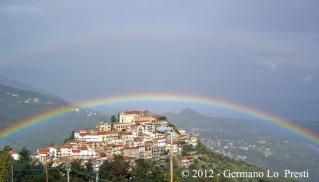
Shall I compare thee to a summer's day?
Thou art more lovely and more temperate:
Rough winds do shake the darling buds of May,
And summer's lease hath all too short a date:
Sometime too hot the eye of heaven shines,
And often is his gold complexion dimm'd;
And every fair from fair sometime declines,
By chance or nature's changing course untrimm'd;
But thy eternal summer shall not fade
Nor lose possession of that fair thou owest;
Nor shall Death brag thou wander'st in his shade,
When in eternal lines to time thou growest:
So long as men can breathe or eyes can see,
So long lives this and this gives life to thee
Yes, this is Sonnet 18 by Shakespeare.
Perhaps you are thinking that the sonnet form arose in England and that Shakespeare was the creator of the form. Wrong! The original sonnets looked more like this:
IO M'AGGIO POSTO IN CORE ...
Io m'aggio posto in core a Dio servire,
com'io potesse gire in paradiso,
al santo loco ch'aggio audito dire,
u' si mantien sollazzo, gioco e riso.
Sanza mia donna non vi voria gire,
quella c'ha blonda testa e claro viso,
chè sanza lei non poteria gaudere,
estando da la mia donna diviso.
Ma no lo dico a tale intendimento,
perch'io peccato ci volesse fare;
se non veder lo suo bel portamento
e lo bel viso e 'l morbido sguardare:
chè lo mi teria in gran consolamento,
veggendo la mia donna in ghiera stare.
Iacopo da Lentini, written in the vernacular Sicilian of the 13th century
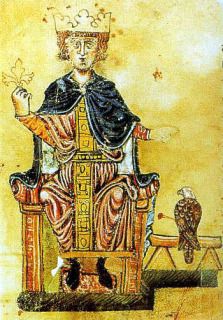
The Sonnet was born in Palermo, Sicily, during the reign of Frederick II (1194-1250),also known as the Stupor Mundi(“The Wonder of the World”).
Frederick was a learned, progressive, ruler and poet. He surrounded himself with the best minds of Sicily, mainland Italy, and France.It was at his Magna Curia, the Royal Court,that the Scuola Siciliana was established. The Sicilian School was not an institution but a philosophic and literary movement.
The poets of this school were all high court officials, administrators, organizers, who were inspired to express themselves poetically. The School was made up of a small group of poets who between 1230 and 1250 wrote over 300 lyric poems. A few of the notable poets were Iacopo da Lentini (Lentini is a town between Catania and Siracusa), Pier della Vigna, Filippo da Messina,and Cielo d’Alcamo. The principal exponent of the Sicilian School was Iacopo da Lentini, in fact he is considered the creator of the form called Sonetto or Sonnet in English.
Troubadours from provenzal France who had been exiled from Provence, took refuge in Palermo, at the court of Frederick II where artistic development was cultivated. Their love poetry which was written in Langue d’oc , inspired the Sicilian poets and became the basis of the new form. However the language used by the Sicilian poets was not that of the troubadours but the Sicilian dialect which existed side by side with Latin. Hence the School established the vernacular, the Sicilian dialect, as the standard language for Italian love poetry.
The themes of courtly love as expressed in the troubadours’ poems are, homage to the woman,her virtue,her physical and moral beauty,hope that the love would be reciprocated by the lady,her modesty in not revealing her own passion. In the Sicilian poems the courtly themes remain but they are stylized, and are no longer concrete but abstract. There is no mention of specific time nor place.
Another fundamental difference is that while the poetry of the troubadours dealt with moral, civil, and political themes, the Sicilian poetry eliminated these aspects and concentrated on courtly love.
The music that accompanied the troubadours’ poems was also eliminated, and new metric forms were introduced, among which were the ‘canzone’ and the ‘sonetto'. Sonetto means ‘little sound’ or ‘little song’.
The Sonnet of the Sicilian Court of Frederick II (early 13th century) has these features:
Sicilian Octave.. a. b. a. b. . a. b. a. b
Sicilian Sestet.. c. d. c. d. c. d.
Pre-Iambic Pentameter
The epitaph of Giulia Topazia is an example of the Sicilian octave:
Qui, d'Atropos il colpo ricevuto,
giace di Roma Giulia Topazia,
dell'alto sangue di Cesare arguto
discesa, bella e piena d'ogni grazia,
che, in parto, abbandonati in non dovuto
modo ci ha: onde non fia giá mai sazia
l'anima nostra il suo non conosciuto
Dio biasimar che fè sí gran fallazia.
English (non-rhyming translation):
Here, having received Atropos's blow,
lies Giulia Topazia of Rome
descended from the high bloodline of witty Caesar,
beautiful, and full of every grace,
who, in childbirth, abandoned us in a manner that ought not be:
thus, our minds will never have enough
of cursing her God, unknowable,
who might make such a great error.
(In my opinion, the English translation does not do justice to the beauty of the actual epitaph)
As I mentioned above, Iacopo da Lentini (1188-1240), the chief Court notary, is considered the creator of the sonnet and its new metric innovation. Of the original poems 125 have survived, 85 canzones and 30 sonnets.Forty of these lyrics,including sonnets and canzones,are by Iacopo da Lentini. Iacopo adapted the themes, style, and language of Provencal poetry to Sicilian, and infused it with his own aristocratic tastes. None of his poetry survives in the original Sicilian as it was somewhat modified to conform to a Tuscan dialect (more about this in part two of the blog).
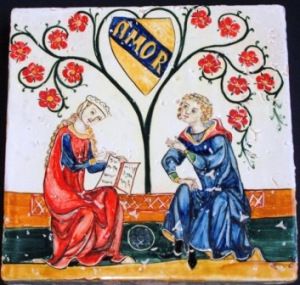
Iacopo da Lentini not only invented the sonnet, he is also credited with the first definition of ‘love’ in literature:
“Amor é un desio che ven da core
per abundanza de gran plazimenti,”
Love is a desire that comes from the heart
Due to an overabundance of pleasures
It was Dante Alighieri who first acknowledged the Sicilian School and the court of Federico II. In his ‘De Vulgari Eloquentia’ Dante discusses the Sicilian School, gives it credit for introducing the sonnet, a new and revolutionary metric system. Dante also immortalized Iacopo da Lentini as well as Pier de la Vigna in his famous “Divine Comedy”. Iacopo is found in Canto XXIV of “Purgatory” where he is referred to as the Notaro (notary), and Pier de la Vigna is found in Canto XIII of “Inferno”. Pier is placed in “Inferno” because when he lost Federick’s trust, Pier committed suicide.
I conclude this first part on the evolution of the sonnet with the following quote:
“The importance of the poetic forms bequeathed by the Sicilian school can scarcely be overstressed. The canzone became a standard form for Italian poets for centuries. The Sicilian-school sonnet became, with variations, the dominant poetic form not only in Renaissance Italy—where it was brought to perfection by Guido Cavalcanti, Dante, and Petrarch—but also elsewhere in Europe, particularly in Elizabethan England, where, after its introduction in the 16th century, it was modified to form the distinctive English, or Shakespearean, sonnet.”
Quote from: http://universalium.academic.ru/245353/Sicilian_sc hool

Leighton, 'God Speed'
